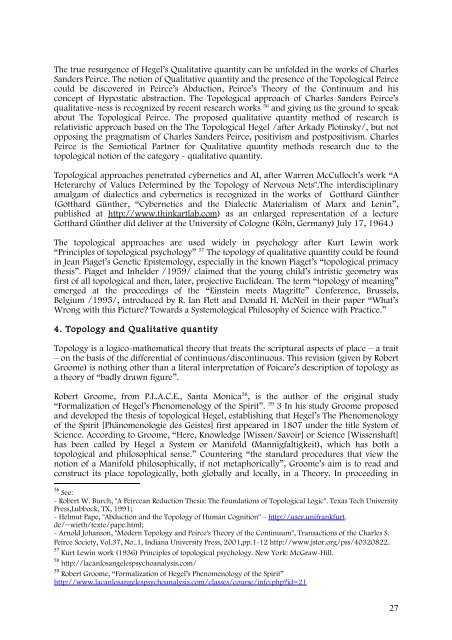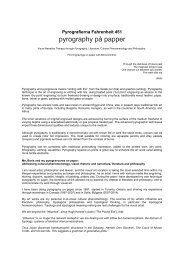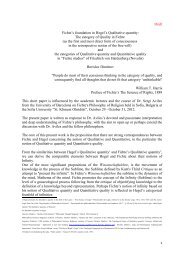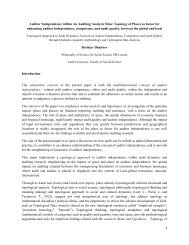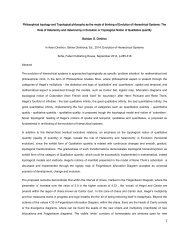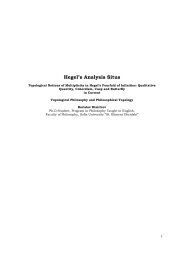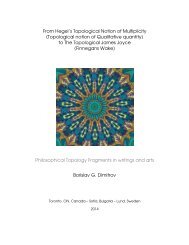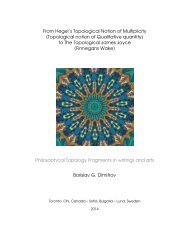Topological Ontology and Logic of Qualitative quantity
Qualitative quantity and BFO (Basic Formal Ontology) of /Barry Smith/ and YAMATO (Yet Another More Advanced Top-level Ontology) of /Riichiro Mizoguchi/
Qualitative quantity and BFO (Basic Formal Ontology) of /Barry Smith/ and YAMATO (Yet Another More Advanced Top-level Ontology) of /Riichiro Mizoguchi/
- No tags were found...
Create successful ePaper yourself
Turn your PDF publications into a flip-book with our unique Google optimized e-Paper software.
The true resurgence <strong>of</strong> Hegel’s <strong>Qualitative</strong> <strong>quantity</strong> can be unfolded in the works <strong>of</strong> Charles<br />
S<strong>and</strong>ers Peirce. The notion <strong>of</strong> <strong>Qualitative</strong> <strong>quantity</strong> <strong>and</strong> the presence <strong>of</strong> the <strong>Topological</strong> Peirce<br />
could be discovered in Peirce’s Abduction, Peirce’s Theory <strong>of</strong> the Continuum <strong>and</strong> his<br />
concept <strong>of</strong> Hypostatic abstraction. The <strong>Topological</strong> approach <strong>of</strong> Charles S<strong>and</strong>ers Peirce’s<br />
qualitative-ness is recognized by recent research works 56 <strong>and</strong> giving us the ground to speak<br />
about The <strong>Topological</strong> Peirce. The proposed qualitative <strong>quantity</strong> method <strong>of</strong> research is<br />
relativistic approach based on the The <strong>Topological</strong> Hegel /after Arkady Plotinsky/, but not<br />
opposing the pragmatism <strong>of</strong> Charles S<strong>and</strong>ers Peirce, positivism <strong>and</strong> postpositivism. Charles<br />
Peirce is the Semiotical Partner for <strong>Qualitative</strong> <strong>quantity</strong> methods research due to the<br />
topological notion <strong>of</strong> the category - qualitative <strong>quantity</strong>.<br />
<strong>Topological</strong> approaches penetrated cybernetics <strong>and</strong> AI, after Warren McCulloch’s work “A<br />
Heterarchy <strong>of</strong> Values Determined by the Topology <strong>of</strong> Nervous Nets".The interdisciplinary<br />
amalgam <strong>of</strong> dialectics <strong>and</strong> cybernetics is recognized in the works <strong>of</strong> Gotthard Günther<br />
(Gotthard Günther, “Cybernetics <strong>and</strong> the Dialectic Materialism <strong>of</strong> Marx <strong>and</strong> Lenin”,<br />
published at http://www.thinkartlab.com) as an enlarged representation <strong>of</strong> a lecture<br />
Gotthard Günther did deliver at the University <strong>of</strong> Cologne (Köln, Germany) July 17, 1964.)<br />
The topological approaches are used widely in psychology after Kurt Lewin work<br />
“Principles <strong>of</strong> topological psychology” 57 The topology <strong>of</strong> qualitative <strong>quantity</strong> could be found<br />
in Jean Piaget’s Genetic Epistemology, especially in the known Piaget’s “topological primacy<br />
thesis”. Piaget <strong>and</strong> Inhelder /1959/ claimed that the young child’s intristic geometry was<br />
first <strong>of</strong> all topological <strong>and</strong> then, later, projective Euclidean. The term “topology <strong>of</strong> meaning”<br />
emerged at the proceedings <strong>of</strong> the “Einstein meets Magritte” Conference, Brussels,<br />
Belgium /1995/, introduced by R. Ian Flett <strong>and</strong> Donald H. McNeil in their paper “What’s<br />
Wrong with this Picture Towards a Systemological Philosophy <strong>of</strong> Science with Practice.”<br />
4. Topology <strong>and</strong> <strong>Qualitative</strong> <strong>quantity</strong><br />
Topology is a logico-mathematical theory that treats the scriptural aspects <strong>of</strong> place – a trait<br />
– on the basis <strong>of</strong> the differential <strong>of</strong> continuous/discontinuous. This revision (given by Robert<br />
Groome) is nothing other than a literal interpretation <strong>of</strong> Poicare’s description <strong>of</strong> topology as<br />
a theory <strong>of</strong> “badly drawn figure”.<br />
Robert Groome, from P.L.A.C.E., Santa Monica 58 , is the author <strong>of</strong> the original study<br />
“Formalization <strong>of</strong> Hegel’s Phenomenology <strong>of</strong> the Spirit”. 59 3 In his study Groome proposed<br />
<strong>and</strong> developed the thesis <strong>of</strong> topological Hegel, establishing that Hegel’s The Phenomenology<br />
<strong>of</strong> the Spirit [Phänomenologie des Geistes] first appeared in 1807 under the title System <strong>of</strong><br />
Science. According to Groome, “Here, Knowledge [Wissen/Savoir] or Science [Wissenshaft]<br />
has been called by Hegel a System or Manifold (Mannigfaltigkeit), which has both a<br />
topological <strong>and</strong> philosophical sense.” Countering “the st<strong>and</strong>ard procedures that view the<br />
notion <strong>of</strong> a Manifold philosophically, if not metaphorically”, Groome’s aim is to read <strong>and</strong><br />
construct its place topologically, both globally <strong>and</strong> locally, in a Theory. In proceeding in<br />
56 See:<br />
- Robert W. Burch, "A Peircean Reduction Thesis: The Foundations <strong>of</strong> <strong>Topological</strong> <strong>Logic</strong>". Texas Tech University<br />
Press,Lubbock, TX, 1991;<br />
- Helmut Pape, "Abduction <strong>and</strong> the Topology <strong>of</strong> Human Cognition" – http://user.unifrankfurt.<br />
de/~wirth/texte/pape.html;<br />
- Arnold Johanson, "Modern Topology <strong>and</strong> Peirce's Theory <strong>of</strong> the Continuum", Transactions <strong>of</strong> the Charles S.<br />
Peirce Society, Vol.37, No..1, Indiana University Press, 2001,pp.1-12 http://www.jstor.org/pss/40320822.<br />
57 Kurt Lewin work (1936) Principles <strong>of</strong> topological psychology. New York: McGraw-Hill.<br />
58 http://lacanlosangelespsychoanalysis.com/<br />
59 Robert Groome, “Formalization <strong>of</strong> Hegel’s Phenomenology <strong>of</strong> the Spirit”<br />
http://www.lacanlosangelespsychoanalysis.com/classes/course/info.phpid=21<br />
27


